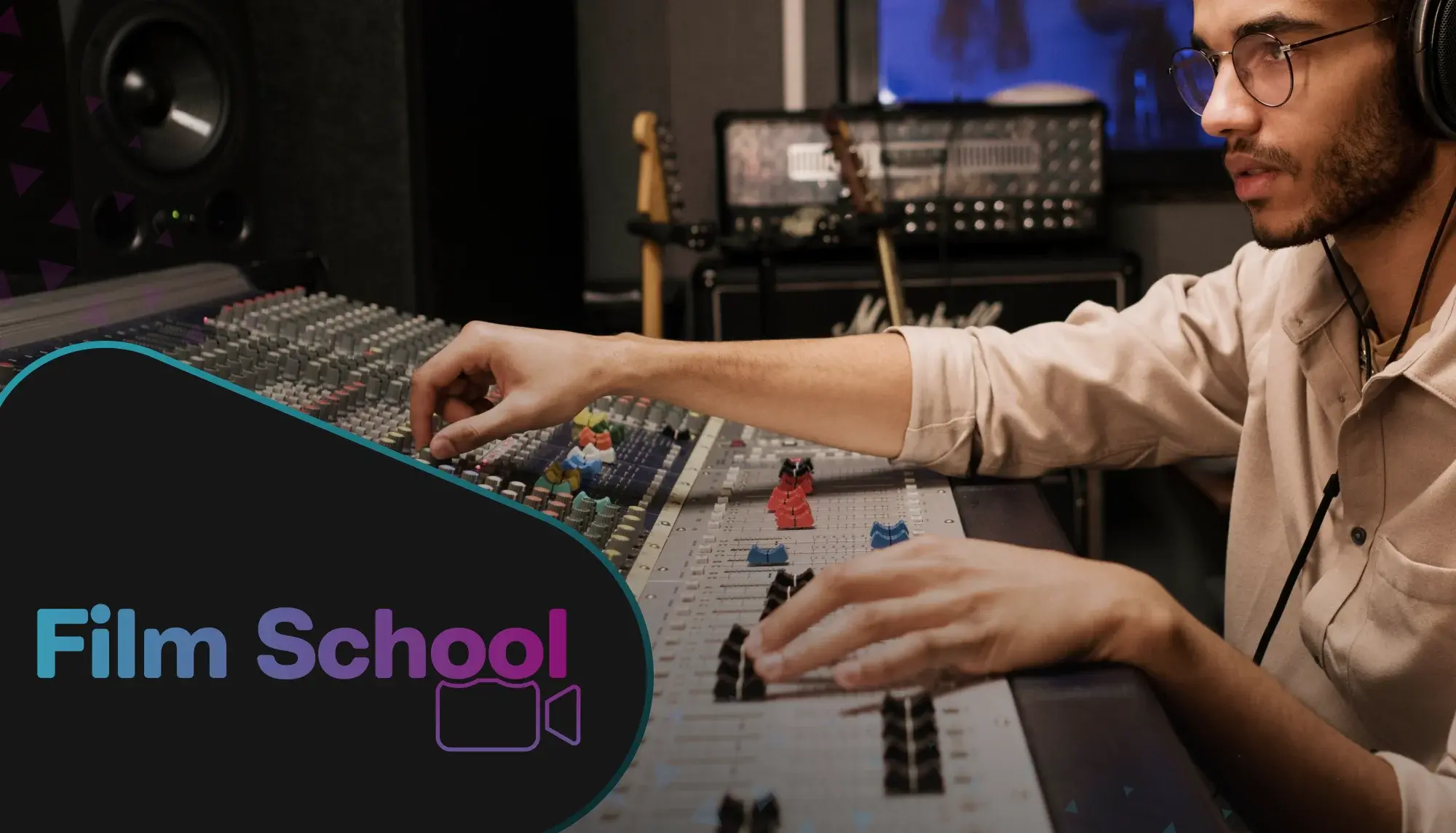
A suspenseful moment. A shocking revelation. A longing glance. A sentimental flashback. A fever pitch of comedic excitement.
These moments can all be enhanced - or ruined - by the right music. And for juuust the right music, a custom movie score does the trick.
Learn about what a movie score is and why they are so important to the viewing experience.
What is a movie score?
A movie score is a piece or multiple pieces of music composed to enhance a specific film. Each individual piece or part of the music is called a cue, and corresponds with specific moments or times of the film. Music composers typically work directly with the director and producers to understand the goals of each plot point and build a composition that brings out the emotions or adds to the tension characters feel in the moment.
While a movie score is music, not all music in movies counts as part of the film score. Songs with words usually aren’t considered score music (though in the case of musicals, the lyrical songs are often based off of the original score). Additionally, diegetic sound, or sounds and music the characters can hear in the scene, is usually not considered part of the score.
For example, in the 1997 film “Titanic,” James Horner created a score to enhance major scenes in the movie, like the moment when the passengers are taking in the magnificence of the Titanic’s luxury in early scenes.
Video via filmsymphony.
Additionally, Celine Dion released a song on the soundtrack, called “My Heart Will Go On,” with lyrics to one of the melodies, but her music was technically not a part of the score.
Notable movie score moments
Theatre has long had musical accompaniment to make moments more impactful. But what about film? Early in the history of film, when movies were still silent due to the technological infancy of the medium, movie theaters began to experiment with musical accompaniments of their own. Here’s how it grew from there.
Pre-1929: Musicians and theaters experimented with silent film accompaniment, using either phonographs or live music to make stories more powerful.
1930-1949: During Hollywood’s Golden Age, composers with backgrounds in classical music crafted intricate pieces to be played by skilled musicians.
1950-1959: Jazz music enters scores, adding new sounds to the mix, with Miles Davis even lending his expertise to films.
1960-1969: Western movies increase in popularity, and with them, the sounds of western movies. Additionally, Simon & Garfunkel soundtrack all the songs to accompany the movie, “The Graduate,” which is technically not a score but does show how popular music can be used to add suspense.
1970-1989: With the rise of synths, composers experiment with using more computerized sounds. John Williams’ star also rises with his iconic classical movie score for “Star Wars.”
1990-present: Movie score sounds run the gamut, with composers incorporating a wider range of instruments and editing styles to create pieces as unique as the movies themselves.
Learn more about the history of movie scores from Film Independent.
What elements make up a movie score?
Movie score elements often accompany specific characters’ story arcs and conflicts they’re going through. Again, we can look to the film “Star Wars” to show some iconic examples of these elements.
Themes
If you’ve ever heard the "Imperial March," you’re hearing a movie score theme. Themes are recurring melodies played during a storyline throughout the film. A film may have multiple themes (because multiple storylines are taking place).
Video via Agostini.
Motifs
Motifs are variations of a theme for a certain character or situation. For example, in “Star Wars,” motifs of the "Imperial March" are associated with Darth Vader and Anakin Skywalker. Check out this compilation with many of the variations seen throughout the saga and see if you can pick out the slight differences among each one.
Video via Star Wars Opinion.
Instrumentation
Simply put, different instruments give the music a different feeling. A large orchestra is going to give a composition a far different vibe, so to speak, than an instrumental rock composition.
For the Cantina Band music from “Star Wars,” John Wiilliams chose jazz instruments to give the music an entirely different feeling from the rest of the franchise’s music. The trumpet, saxophones, clarinet, Fender Rhodes piano, Caribbean steel drum, and various percussion instruments give the final product an upbeat, almost tropical air that just feels right for the nightclub setting of the scene.
Video via John Williams - Topic.
Timing
Of course, the timing and rhythm of these elements is crucial to the pacing of the story. You wouldn’t put a fast-paced song in a scene where a somber moment is taking place. Think about the "Imperial March" again — its steady beat adds a dark, foreboding, almost militant nature to the scenes it’s played in to reiterate the feeling of the Empire’s power.
Together, these elements work alongside the cinematography and other production pieces to build scenes that resonate and leave an impact.
The impact of a movie score on a film
Movie scores can have viewers humming along on their way out of the theater. The score can also make a scene’s message clearer by amplifying the emotions of the characters on-screen.
Sometimes movie scores are so impactful, they become even more well-known than the plot of the film.
Consider “Jaws.” You know the score, but do you even know what happens in the movie?
Video via filmsymphony.
What about the “James Bond” movies? There are so many of them, but the score endures to capture the feeling of the protagonist far beyond the plot points of each individual 007 film.
Video via YouTube.
Okay, something happier. “E.T. The Extra Terrestrial” Flying Theme inspires elation, even for audiences that have never seen the famous film.
Video via The Spirit of Orchestral Music.
A few of our other favorite scores
No blog post on movie scores would be complete without noting Howard Shore’s work for “The Lord of the Rings.” The films are obviously quite well-known throughout popular culture, and while the score doesn’t take the place of the plot, it’s impossible to avoid welling up with good feelings when you hear the sounds of The Shire.
Video via Classic FM.
In his score for “Interstellar,” Hans Zimmer added the sound of a ticking clock. Each tick corresponded to a year’s worth of time on earth that the characters were missing out on, and during some of the more intense scenes that were further away, the ticking sped up, adding to the suspense and literally showing how fast time on earth was passing. Zimmer uses a similar technique in the film “Dunkirk,” as well.
Video via Jay M.
“The Social Network,” composed by Trent Reznor and Atticus Ross of Nine Inch Nails, overcame the Academy’s anti-rock bias to win the Oscar for Best Original Score in 2010. In their early days of working with director David Fincher, they shared their concept for how to reimagine the composition “In the Hall of the Mountain King,” which builds to a climactic moment in the famous rowing scene.
Video via YouTube.
How a movie score gets made
We’ve discussed why movie scores make a huge difference in the impact of a film, but how does it even come to fruition?
1. Spotting and initial discussions
During this collaborative stage, the director and composer work together to identify (or “spot”) which areas of the film will benefit from music. It’s crucial that the composer understands what the director wants to achieve, so they can build a cohesive movie score that adds to, rather than distracts, from the film.
2. Research, research, research
Just like it sounds, the composer spends time researching the themes, characters and even history (when applicable) of the story. They may also spend time in regions influenced by a specific style of music — for a film about jazz, a composer might spend time in New Orleans listening to live jazz music, for example. This stage gives the composer a chance to brainstorm creative ideas that they can showcase in the score.
3. Experiment with raw material
Around or shortly after the research stage, a composer will begin playing with different instruments and styles to build a library of sounds that serve as the foundation for the final compositions. At this point, they’ll work closely with a sound designer to create and capture anything unique.
4. First drafts and mock ups
Now is when the composer actually puts pen to paper (literally or metaphorically) to write the score. Every creative’s process differs, but this is the point when they put pen to paper and maybe even record some demo-style examples to run past the director.
5. Recording, mixing, and mastering
Finally, it’s time to record. Depending on the instruments used, either an orchestra will meet to perform, or recording artists will record their individual parts asynchronously. Then, audio engineers will be pulled in to polish the recordings and make necessary adjustments so that the correct emphasis is on the correct instruments. Once everyone is happy with the “mix” as it’s called, the audio engineer will put the finishing touches on the recordings in the mastering stage, and make sure the audio levels are appropriate for each format the movie will be presented in.
Final thoughts
Movie scores and music can make or break a movie; some of the greatest movies of all time have held up because of their powerful scores. Composers spend so much time planning and figuring out the tiny details to surprise and delight viewers that it’s unsurprising the scores can stick with us long after we’ve forgotten the plot of the film.
Finally, with a library of stock music options (or the ability to upload your own audio files), you can use the secrets of the film industry to create more engaging content with WeVideo. Happy creating!



